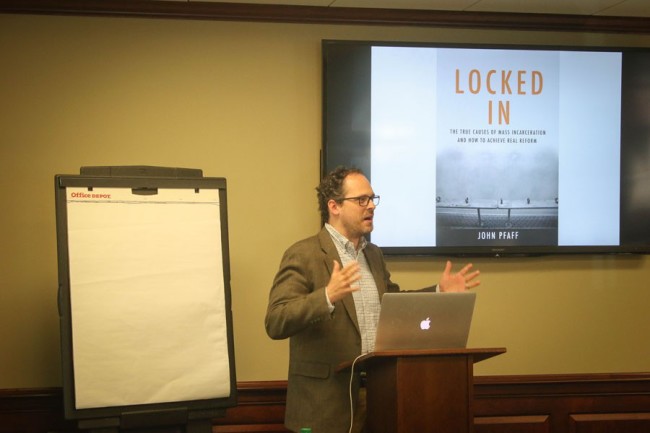
Professor John Pfaff of Fordham University visited the SMU law school April 7 to give a lecture entitled “The Causes of Prison Growth: Prosecution, Violent Crimes and the Public Sector” to students and faculty.
Pfaff, has been teaching criminal law, sentencing law and economics for 11 years at Fordham and is currently doing research in the area of increased incarceration rates in the U.S. for the last 40 years.

Pfaff said there are many factors contributing to the rise in prison populations across the nation and listed four major causes: admission of inmates driven by the District Attorney, the need to focus on violent crime instead of “lower-level” drug crime and overlooked structural and political flaws.
For example, Pfaff asserts that in most recent years, there has been a war on drugs, yet as a nation politicians and law enforcement have not focused on preventing violent crime.
“It’s violent offenders, not drug crimes,” Pfaff said. “Over half of all people in prison are in prison for violent crimes. Everyone in prison for long-term is almost inevitably in there for violent crime.”

“If you want to cut prison population,” Pfaff continued, “at some point, the low-level violent offenders [drug offenders] aren’t going to do much. You’re going to have to ask ‘How do we punish murderers and so far, politicians aren’t raising this issue.”
Pfaff said that private prisons play almost no role in this, yet it is the public prisons that drive this, among many of the other issues that go along with prison reform.
“Many politicians don’t actually want to be tough on crime,” Pfaff said. “But the nature of politics forces them to be tough on crime.”
In fact, according to Pfaff, every year the U.S. releases half of all inmates from prison, and that ratio hasn’t moved much from 1978 to 2014.
“We have crazy sentences on the books, but we don’t actually have that. The time on the books rarely reflects the time that is actually sought by the DAs…adding extra time adds almost no benefit,” he said.
In other words, more and more people are being prosecuted due to a rise in prosecution power, resulting in an increase of arrests for charges like drug-related offenses, filling up prisons monumentally.
“Between 1980 and 2010, there was a net decline of arrests — fewer people physically entering the criminal justice system at the felony level. Yet during that time, the number of felony cases, not arrests, but cases filed in a courtroom, rise by 40 percent,” Pfaff said.
He said this is the main reason why we see almost all growth in prisons.
“It is not longer sentences that is driving growth — it’s the DA,” Pfaff continued. “They become aggressive, unregulated, uncontrolled…and no one has any idea why.”
During his lecture, Pfaff went into great detail about the reasons why there are issues in prisons around the nation, and why there has been much growth over the past twenty years. The way to reform prisons? According to Pfaff, there must be funding of public defenders, more data about the issues and on DAs, plea-bargaining guidelines and realignment of the entire system.
“We must change the culture,” Pfaff said of prison. “The laws aren’t going to get us where we need to go.”











